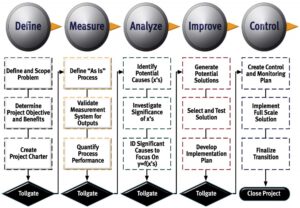Six Sigma is a process improvement methodology as well as a statistical concept that seeks to describe the variance inherent in each process. Six Sigma’s basic principle is that variance in a process creates the potential for error, and opportunities for error create risks for product defects. Poor customer satisfaction results from product failure, whether in a tangible process or a service. The Six Sigma method decreases process costs, and promotes customer satisfaction by aiming to reduce variance and the potential for error.
At its most basic, Six Sigma is a statistical representation of what many professionals refer to as a ‘perfect’ process. Technically, there are only 3.4 errors per million opportunities in a Six Sigma process. In percentage terms, this indicates that 99.99966 percent of Six Sigma goods are defect-free.
What Six Sigma actually is
- A Business strategy: Using the Six Sigma methodology, a business may construct its action plan and promote revenue growth, cost reduction, and process improvements throughout the entire organisation.
- A vision: The Six Sigma methodology assists senior management in developing a vision to produce a positive, defect-free environment for the organisation.
- A benchmark: Six Sigma methodology facilitates the enhancement of process metrics. Once the enhanced process measurements have attained stability, the Six Sigma approach can be used to further improve the newly stabilised process metrics.
- A goal: Using the Six Sigma process, businesses can set a rigorous goal, and work toward attaining it over the course of the year. Typically, these firms are able to attain these objectives as a result of their appropriate application of the technique.
- A statistical approach: Six Sigma is a data-driven technique. Statistical analyses are performed to uncover the problem’s root causes. In addition, the Six Sigma technique uses its own unit, known as the Sigma unit, to calculate process performance.
- A robust approach: Six Sigma is the only problem-solving methodology on the market that is supported by documentation. Six Sigma enhancements are bullet-proof and produce substantial returns if implemented correctly.
Why Six Sigma?
There are endless possibilities to the application of Six Sigma. Compared to other methodologies in Total Quality Management, Six Sigma promotes a culture of continuous improvement and quality to optimise an organisation’s performance. Six Sigma’s culture lets firms make modest and large changes that boost efficiency and cost. Each project in Six Sigma has goals, but the culture of improvement is never finished.
The most significant advantage of Six Sigma can be summed up in the following equation:
SPC + ADT + PE + DFM + QTP + JQJ = 6σ
Where
- SPC= Statistical Process Control;
- ADT= Advanced Diagnostic Tools;
- PE= Planned Experimentation;
- DFM= Design for Manufacture;
- QTP= Quality Through Projects;
- JQJ= Juran’s Quality Journey
(Ramberg J.S. Six Sigma: Fad or Fundamental. Quality Digest)
Additionally, Six Sigma = TQM + Stronger Customer Focus + Additional Data Analysis Tools + Financial Results+ Project Management. (Anbari, F.T. (2002) ‘Six Sigma Method and Its Applications in Project Management’, Proceedings of the Project Management Institute Annual Seminar and Symposium, San Antonio, Texas).
Perspectives of Six Sigma
- Philosophy: Six Sigma’s philosophical perspective views all work as processes that can be defined, monitored, analysed, enhanced and managed. Processes require inputs (x) and create outputs (y). You will control the outputs if you control the inputs. Typically, this is represented as y = f(x).
- Set of tools: The Six Sigma expert uses qualitative and quantitative approaches or tools to enhance processes. Statistical process control (SPC), control charts, failure mode and effects analysis (FMEA), and process mapping are examples of such techniques.
- Methodology: This perspective on Six Sigma methodology acknowledges the rigorous DMAIC methodology. DMAIC specifies the stages a Six Sigma practitioner must take, beginning with the identification of the problem and concluding with the deployment of durable solutions. Although DMAIC is not the only Six Sigma approach in use, it is by far the most popular and well-known.
- Metrics: Simply said, Six Sigma quality performance corresponds to 3.4 faults per million chances (a 1.5-sigma shift in the mean).
The Six Sigma DMAIC overview
The five steps of DMAIC—defining, measuring, analysing, improving and controlling—improve processes using data. The acronym represents the five process steps and the resources needed to complete them. It’s often utilised in Six Sigma initiatives but it can also be used alone or with other process-improvement methodologies like LEAN.
- Define the issue, the improvement activity, the opportunity for improvement, the project’s objectives, and the internal and external customer needs.
- A project charter to define the focus, scope, direction and incentive for the improvement team.
- Voice of the customer to comprehend feedback from existing and future customers regarding offerings that satisfy, delight and dissatisfy them.
- Value stream map to provide an overview of a full process, beginning and ending with the customer, and examining what is necessary to satisfy consumer needs.
- Measure the performance of the process.
- Process map for documenting the activities conducted within a process of capability analysis for evaluating a process’ capacity to meet specifications.
- Pareto analysis to determine the frequency of problems or causes.
- Analyse process to discover the underlying reasons of variation defects.
- Root cause analysis (RCA) to discover causes.
- Failure mode and effects analysis (FMEA) to detect potential product, service and process failures.
- Multi-variate graphic for identifying different types of process variation.
- Improve process performance by identifying and eliminating the underlying reasons.
- Design of experiments (DOE) to solve problems from complex processes or systems where multiple factors influence the outcome, and it is impossible to isolate a single factor or variable.
- Kaizen event to introduce rapid change by focusing on a narrow project and utilising the ideas and motivation of the people who do the work.
- Control the performance of the upgraded process and its future performance.
- Quality control plan to document what is required to maintain an enhanced process at the current level.
- Statistical process control (SPC) for monitoring process behavior.
- 5S to provide a visual control environment.
- Mistake proofing (poka-yoke) to make errors difficult or instantly detectable

Benefits of Six Sigma
- Customer satisfaction.
Six Sigma tends to boost customer satisfaction by minimising possible problems and eliminating unnecessary process specifications. A happy customer is a satisfied customer. Thus, Six Sigma aids in achieving customer loyalty and retaining customers.
- Removal of variability and waste from the process
Six Sigma is a data-driven method for removing undesirable actors from a process, hence, eliminating variation and deviation. Thus, Six Sigma helps to discover process improvement opportunities.
- Employee motivation
Six Sigma helps to encourage the employees of an organisation by guaranteeing that they can use the available technologies to save time and operate more efficiently. When workers are motivated and inspired to continue working and pushing themselves to their limits, productivity increases automatically.
- Strategy development
Six Sigma analyses possible process concerns in advance, allowing the project management team to strategise and plan to decrease and eliminate problems and waste to maintain product and service quality, and productivity. It helps the project management team discover business process strengths and weaknesses, eliminating superfluous procedures.
Pitfalls to avoid when implementing Six Sigma
- Anticipating rapid results
Six Sigma is implemented in many organisations without structure. Companies that provide staff with training anticipate that they will deliver Six Sigma projects as soon as they leave the classroom. It is virtually impossible for them to generate additional returns in the month following training.
- Selecting inappropriate projects.
Six Sigma is a proven strategy for achieving improvement in a structured manner. In order to enjoy the benefits of Six Sigma as rapidly as possible, firms urge the Six Sigma team to undertake initiatives outside of their expertise. This will cause the project to become unmanageable. This erroneous selection of the project could result in the resource employing their skills on an undesirable endeavour.
- Insufficient management support.
The complete backing of management for a Six Sigma project is crucial. The success of a Six Sigma project is dependent on the management and leadership of the project. Absence of management support will render the improvement effort ineffective. A lack of leadership for the Six Sigma project will result in the project failing before it even begins. This eliminates all resource-based works. Without adequate leadership support, the team will be unaware of the project’s direction.
Conclusion
This article has given you an introduction on the methodology used by Six Sigma teams to solve problems and enhance processes. Teams use staged approaches whether they are enhancing an existing process or developing a new process or product. DMAIC’s phases will help your team stay on track, stay focused, and break down what may initially seem like an insurmountable assignment into more manageable bits.










